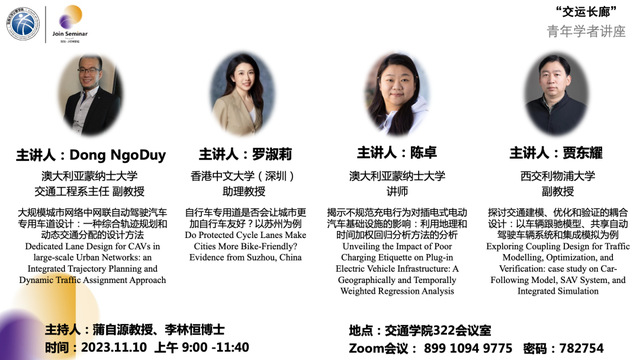

Dong NgoDuy
Head of the Transport section at Monash University, associate professor
Dedicated Lane Design for CAVs in large-scale Urban Networks: an Integrated Trajectory Planning and Dynamic Traffic Assignment Approach
Autonomous vehicles (AVs) are expected to revolutionize transportation by promising enhanced safety, cost efficiency, increased mobility options, and reduced traffic congestion. Planning individual AV's dynamics in mixed traffic scenarios with traditional human-driven vehicles (HDVs) can enhance overall traffic performance, spanning safety, fuel efficiency, and emission reductions. However, existing literature primarily focuses on specific road segments, such as highway merges and urban intersections, in temporal scales. In response, this paper aims to explore the adaptable and versatile nature of AVs across entire networks, encompassing both spatial and temporal dimensions. To this end, we introduce a bi-level control framework designed to optimize traffic flow and signal control in a mixed traffic network comprising AVs and HDVs, while simultaneously planning AV trajectories to reduce fuel consumption across network links. Our proposed framework maintains the coherence of mixed traffic characteristics between the network-level and link-level layers, leveraging Newell's car-following model and its underlying principles. An efficient algorithm is developed to iteratively solve linear programming (LP) models for both the upper (network level) and lower level (link level). Numerical results reveal that the inclusion of AVs leads to a substantial reduction in fuel consumption, even at low penetration rates. Furthermore, AVs contribute to decreased network-wide travel time and alleviate congestion at intersections.

Luo Shuli
School of Humanities and Social Science at the Chinese University of Hong Kong (Shenzhen), assistant professor
Do Protected Cycle Lanes Make Cities More Bike-Friendly? Evidence from Suzhou, China
Creating a sustainable and cyclist-friendly urban environment is essential for urban development. While many studies rely on site visits or geospatial techniques to evaluate Bikeability using various neighborhood-level indicators, few address detailed street-level features, partially due to data scarcity. This study presents a comprehensive framework that leverages deep learning techniques and street view images (SVIs) to evaluate Bikeability, considering both neighborhood and street-level built environment (BE) features. Factor analysis is applied to categorize extracted BE features into three main factors: Safety, Comfort & Pleasurability, and Accessibility & Feasibility. The spatial variation of Bikeability index highlights disparities within and among cycle lane categories, influenced by the interplay of BE features. This challenges the prevailing assumption that protected cycle lanes always ensure better Bikeability. These insights would offer valuable policy implications, guiding the development of targeted initiatives in enhancing bike-friendly environments, especially in historical areas with distinct spatial characteristics.

Chen Zhuo
Lecturer in the Civil Engineering Department at Monash University and a Research Fellow at Monash Suzhou Research Institute
Unveiling the Impact of Poor Charging Etiquette on Plug-in Electric Vehicle Infrastructure: A Geographically and Temporally Weighted Regression Analysis
Poor charging etiquette of Plug-in Electric vehicle (PEV) drivers, such as unplugging other PEVs and overstaying after the PEV is fully charged, will create a service bottleneck to charging resources and even impede PEV penetration. To explore the underlying linkage between PEV drivers’ interim activities and the behavior of overstaying, this study introduces an innovative framework that implements Geographically and Temporally Weighted Regression (GTWR) with a dedicated activity-based Bayesian inference module. Specifically, the stochasticity of EV drivers’ travel behaviors is well addressed in the Bayesian inference module for travel choice modeling during charging sessions. Subsequently, the GTWR model is constructed based on predicted travel choices and expected durations of activities to capture the spatiotemporal interconnections between overstaying and activity characteristics. The proposed modeling framework is further applied to a real-world case study and demonstrates superior adaptability in reasoning the impacts of spatiotemporal factors without survey data.

Jia Dongyao
Associate Professor at the School of Advanced Technology, Xi’an Jiaotong-Liverpool University (XJTLU)
Exploring Coupling Design for Traffic Modelling, Optimization, and Verification: case study on Car-Following Model, SAV System, and Integrated Simulation
Research in intelligent traffic flow typically involves interdisciplinary intersections, particularly in light of the rapid advancements in vehicular communication and artificial intelligence. To effectively address specific issues within intelligent traffic management, it is essential to adeptly combine methods and theories from different disciplinary domains. This presentation will briefly introduce our recent and ongoing work on the use of coupled design methods: traffic flow modeling by combing kinetic model with deep learning, vehicle dispatch optimization for shared autonomous vehicle systems by coupling prediction and scheduling algorithms, and the design of a simulation platform for mixed traffic scenarios by integrating different open-source software. Preliminary results suggest that the effective application of interdisciplinary coupling methods is highly impactful when tackling complex issues like intelligent mixed traffic flow.